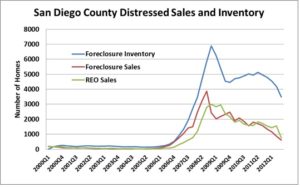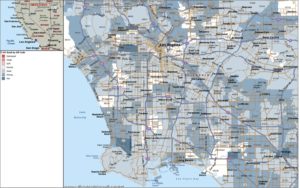Collateral Analytics Research: September 2012 Market Update
It is becoming widely accepted that real estate markets in many parts of the country are in recovery mode. In fact, the transition from weak to good market conditions in many metros has been quite rapid.
A significant concern in recent years has been the potential for a large inventory of distressed homes flooding the market and stifling the recovery. This, however, has not materialized. Figure 1 below shows a chart estimating San Diego County quarterly foreclosure sales, REO sales, and the number of bank-owned properties or the so-called “foreclosure inventory.” As seen, the foreclosure inventory has been in a clear declining trend for the past several years and is currently at its lowest level since 2008.
Figure 1
With regard to this foreclosure inventory, there has been a misperception that it is a problem for the entire market. In fact, it is quite concentrated in specific cities and neighborhoods. For this reason, potential buyers who have been waiting for bargain prices in desirable neighborhoods are being disappointed. This is another reason why it is so misleading to follow nationwide, state and metro level real estate statistics. The aggregated numbers may be correct but they are often meaningless since the assumption is that the trends and counts are evenly distributed across all sub-markets and neighborhoods, which they are not.
One of the reasons we are mentioning the San Diego market is that it is one of four Southern California real estate markets which appear in our Top 10 CBSAs this month. Figure 2 shows a 20-year history of the more traditional Months of Inventory Remaining trends for homes listed for sale for the largest three of these CBSAs. As seen, current readings are now the lowest they have been since the market peak in 2005-2006.
Figure 2 Source: CAR
In addition, the current overall Months of Inventory Remaining for all three counties is below 5 months. This is significant because in the Los Angeles market over the past 25 years, whenever this indicator was below 5 months the median single family price increased by 18.9% in the following year. While all Los Angeles market indicators are moving in a positive direction it remains to be seen if the same appreciation happens this time.
While all three counties exhibit low overall inventory remaining numbers, there is actually a fairly wide dispersion of these values when viewed by home value expressed on a price per square foot of living area basis. Figure 3 shows the MRIs by price/living range and as can be seen, the lowest priced areas are currently showing the tightest inventory levels.
Figure 3
CBSA Winners and Losers
Each month Collateral Analytics ranks the single family home markets in the top 200 CBSAs to highlight the best and worst metros with regard to a number of leading real estate market based indicators.
The ranking system is purely objective and is based on directional trends. Each indicator is given a score based on whether the trend is positive, negative, or neutral for that series. For example, a declining trend in active listings would be positive as will be an increasing trend in average price. A composite score for each CBSA is calculated by summing the directional scores of each of its indicators. From the universe of the top 200 CBSAs, we highlight each month the CBSAs which have the highest and lowest composite scores.
The tables below show the individual market indicators which are being used to rank the CBSAs along with the most recent values and the percent changes. We have color-coded each of the indicators to help visualize whether it is moving in a positive (green) or negative (red) direction.
Top 10 CBSAs
The top ranked metros in the current month represent an interesting mix of U.S. real estate markets. As discussed earlier, four of the top ranked CBSAs are located in Southern California. In addition, there are four Texas markets in this list including Houston and Fort Worth-Arlington. Note that all the indicators in the Top 10 list are colored green which means that they are exhibiting positive trends. One thing that all these markets have in common is that they all have experienced significant declines in active listing counts over the past year. This has led to most of these currently having balanced or tight markets based on their Months of Inventory Remaining values.
Bottom 10 CBSAs
In contrast, a high percentage of the bottom ranked metros continue to be located in the Northeast. Most have double digit Months of Inventory Remaining. Our top and bottom ranked CBSAs are ranked on a relative basis. Thus, even the ones in the Bottom 10 list are showing a fair percentage of positive (green) trends. This is quite different from last year when the majority of the Bottom 10 markets had most (or all) of their indicators trending negative and colored red.
Our Market Condition thematic maps are a good way to visualize the differences in the top and bottom ranked metros. Figure 5 below shows the single family rankings for the Los Angeles area while Figure 6 shows the same for the New York Metropolitan area
Figure 5
Figure 6
Outliers
In this month’s Outliers, we highlight the San Diego-Carlsbad-San Marcos, CA CBSA, which is currently in the list of the Top 10 metros. All the top ranked California metros have experienced significant price declines since the market peak in 2006, and this metro is no exception. In fact, the price peak in this overall metro occurred in the first quarter of 2006 and the median single family price has since declined 39.3 percent. Like any market, bargain prices will bring out buyers and this is clearly happening in the San Diego CBSA. As seen in the ranking table above, all of its important market indicators are showing positive trends on a year-over-year basis including declining inventory, declining market times and lower distressed sales activity to name a few.
Within the San Diego CBSA there are numerous sub-markets. On a ZIP code level, one of particular interest is ZIP code 92024, Encinitas, CA.
Figure 7
As seen in Figure 7, single family home prices in this ZIP code have held up better than in the overall San Diego metro and are currently down only 12.8 percent from the market peak.
There are a number of reasons for the historical and forecasted outperformance of this ZIP code which include the fact that homebuyers in this ZIP code have been better capitalized and, thus, better able to weather declines in home prices. The average loan-to-value (LTV) ratio in ZIP 92024 has historically been about 72 percent compared to approximately 80 percent for the overall San Diego CBSA.







